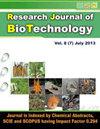Flower waste as a potential substrate for biosurfactant production
IF 0.2
Q4 BIOTECHNOLOGY & APPLIED MICROBIOLOGY
引用次数: 0
Abstract
To know the potential of flower waste as a substrate for biosurfactant production, strains of pure isolated fungi F1, F2, F3, F4 and F5 were used for the study. Different screening methods were done to test the production of biosurfactant: Emulsification Index Test, Drop Collapse Test, Oil Spreading Test, CTAB Agar Test and Hemolytic Activity Test. The highest percentage of biosurfactant concentration for Emulsification Index Test i.e. E24 value was shown by F1 and F3 with 54.16%. The highest clearing zone for Oil Spreading Test was shown by F1 and F3 strain with 2.2 cm diameter. The Drop Collapse Test was shown positive by F1 and F3 strain with flattening of 1mm as compared with distilled water. The clearing zone around the wells for hemolytic activity was shown by both F1 and F3 strain. CTAB Agar Test showed that out of the five fungal strains, F1 and F3 showed blue halos around the wells and hence are anionic in nature. Thus, flower waste has the potential for the production of biosurfactant as a low-cost substrate which can yield high value biosurfactant.将花卉废弃物作为生产生物表面活性剂的潜在基质
为了解花卉废弃物作为生物表面活性剂生产基质的潜力,研究采用了纯分离真菌 F1、F2、F3、F4 和 F5 菌株。采用不同的筛选方法测试生物表面活性剂的生产情况:乳化指数测试、液滴塌陷测试、油扩散测试、CTAB 琼脂测试和溶血活性测试。在乳化指数测试(即 E24 值)中,F1 和 F3 的生物表面活性剂浓度百分比最高,为 54.16%。F1 和 F3 菌株在展油试验中显示出最高的清除区,直径为 2.2 厘米。与蒸馏水相比,F1 和 F3 菌株在水滴塌陷试验中显示出正面效果,扁平 1 毫米。F1 和 F3 菌株的溶血活性孔周围出现了透明区。CTAB 琼脂测试表明,在五种真菌菌株中,F1 和 F3 在孔周围显示出蓝色光晕,因此具有阴离子性质。因此,花卉废弃物作为一种低成本底物,具有生产生物表面活性剂的潜力,可以产生高价值的生物表面活性剂。
本文章由计算机程序翻译,如有差异,请以英文原文为准。
求助全文
约1分钟内获得全文
求助全文
来源期刊

Research Journal of Biotechnology
BIOTECHNOLOGY & APPLIED MICROBIOLOGY-
CiteScore
0.60
自引率
0.00%
发文量
192
期刊介绍:
We invite you to contribute Research Papers / Short Communications / Review Papers:
-In any field of Biotechnology, Biochemistry, Microbiology and Industrial Microbiology, Soil Technology, Agriculture Biotechnology.
-in any field related to Food Biotechnology, Nutrition Biotechnology, Genetic Engineering and Commercial Biotechnology.
-in any field of Biotechnology related to Drugs and Pharmaceutical products for human beings, animals and plants.
-in any field related to Environmental Biotechnolgy, Waste Treatment of Liquids, Soilds and Gases; Sustainability.
-in inter-realted field of Chemical Sciences, Biological Sciences, Environmental Sciences and Life Sciences.
-in any field related to Biotechnological Engineering, Industrial Biotechnology and Instrumentation.
-in any field related to Nano-technology.
-in any field related to Plant Biotechnology.
 求助内容:
求助内容: 应助结果提醒方式:
应助结果提醒方式:


